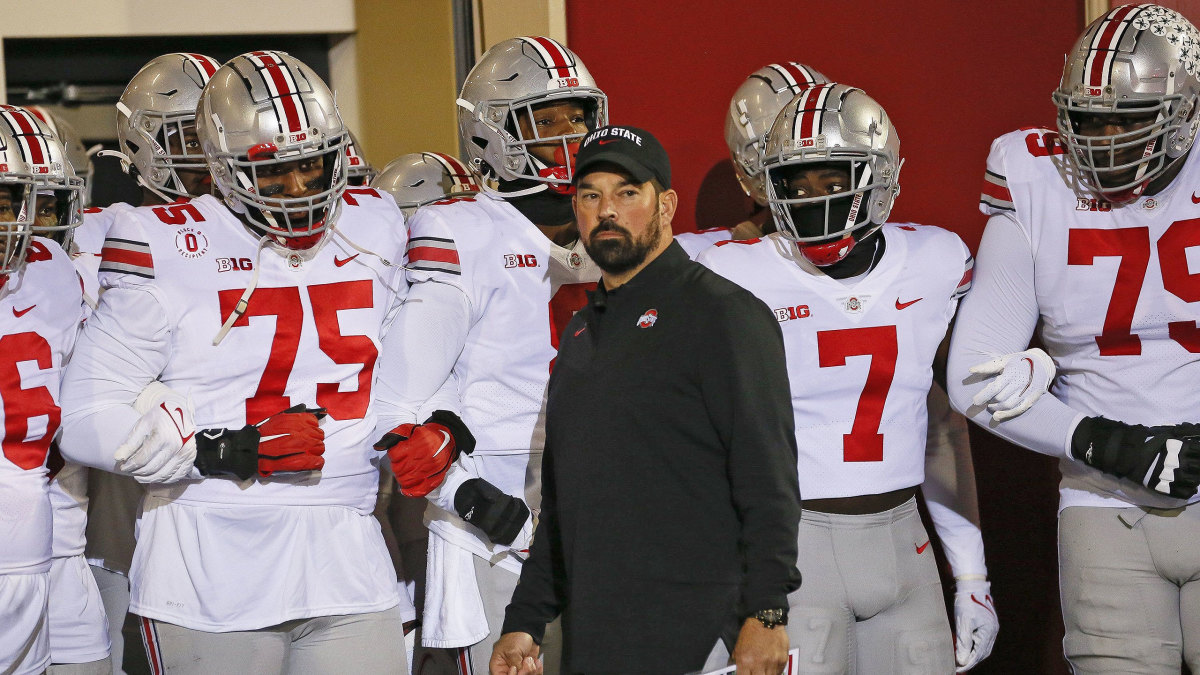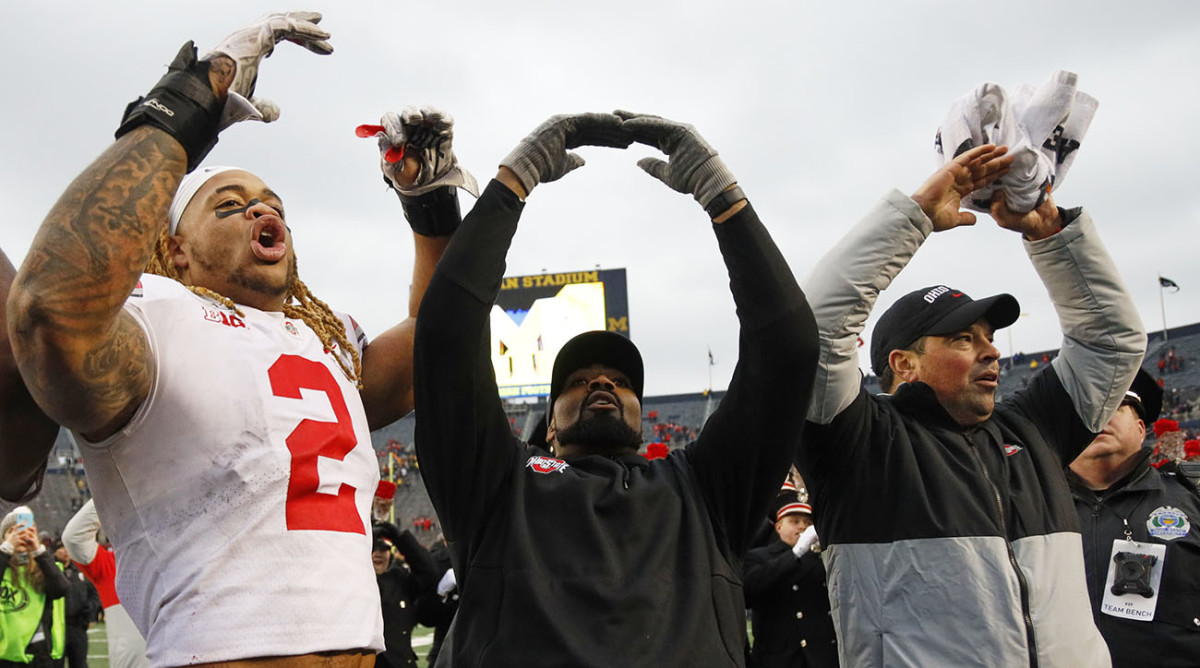Still Feeling the Sting of a Year Without The Game, Ohio State Is Raring to Go
Hung along the western wall of Gene Smith’s office are about one dozen commemorative footballs, emblazoned with the date, location and final score of a specific game. This is a football lover’s wall art—if you’re a fan of a particular team from central Ohio.
Many of these oblong-shaped, white-and-brown keepsakes mark victories for the Ohio State Buckeyes against their most hated nemesis. Most here don’t say or write the name of that archrival. In fact, on a whiteboard in his office, Smith, in his 17th year as Ohio State’s athletic director, has scribbled this season’s schedule week by week. The entry for Nov. 27 is written in red marker.
@ TTUN
Across the room, on that western wall, a football is inscribed with the score of the 2018 meeting between these two teams:
Buckeyes 62, The Team Up North 39
The Michigan Wolverines helmet, positioned at the far right of the football, is noticeably crossed out with a red X. Because why not deface their logo as well as refuse to write their name?
The ball has some significance. Unbeknownst to Smith when he hung it, that game would be the last time Michigan and Ohio State would play at the Horseshoe for a stretch of four years—the longest in series history in more than a century.

For the first time since 1917, the two teams didn’t play last year after a COVID-19 outbreak on Michigan’s team. The Ohio State fan base reacted with one of the fiercest and loudest swells of “venom” that Smith has ever seen.
“People went nuts,” Smith says. “I got a lot of, ‘They’re running away from us!’ But that wasn’t true.”
And yet, days before one of the most significant chapters in this 116-game series—No. 2 Ohio State at No. 5 Michigan—not everyone in Columbus is convinced of that.
The Ohio State community, the city and even those on campus question the legitimacy of Michigan’s cancellation last year ahead of a game in which the Wolverines were a 30-point underdog. The decision snapped a 102-year stretch of consecutive games between the two teams and cost Ohio State a home game—and in all likelihood, a 52nd victory in the series.
The cancellation, rooted in the Big Ten’s COVID-19 protocols, is lingering over this year’s duel, seen by many as more fuel for a team that has dominated the rivalry for two decades. Did they really need any more motivation for a hate-filled series pitting two top-five teams with Big Ten and national championship aspirations on the line?
Maybe not. Or maybe so.
“There’s a prevailing feeling in the city and around the program that the game could have been played,” says Bobby Carpenter, a former Ohio State linebacker and media personality in Columbus who is close to the program. “Given how the outcome was probably predetermined, maybe Michigan took an easy way out. A lot of people feel that way, including those in the Woody Hayes Center.”
The Woody Hayes Center is the Buckeyes’ football facility, encompassing the team’s locker room, coaches’ offices and meeting rooms—the soul of the program. On Tuesday afternoon, from a lectern in that building, Ryan Day shook off any notion that the cancellation provides any more motivation for the team. After all, aren’t the stakes enough?
“It’s a chance to go to Indianapolis,” he said, referencing the site of the conference title game.
Among former players, within the fan base and even from some on campus, last year’s cancellation is tattooed on history, branded on their minds forever, a scar in the consistency of a matchup between two teams separated by three hours.
Simply put, many here are angry.
“The way Michigan handled it last year with maybe using COVID as an excuse, maybe not, whatever it might be, I know Ohio State feels cheated,” says Zach Boren, a former linebacker for the Buckeyes under Urban Meyer, a leading businessperson in Columbus and a close supporter of the school.
“Players come to Ohio State to play that game, and they lost the opportunity to play that game. That game defines your legacy and who you are as a player. They lost out on that opportunity and it’s going to be fueling those guys this week.”
Earlier this week, Michigan linebacker Josh Ross called the accusations “b.s.”
“As a Michigan Wolverine, that’s a game you die for,” Ross said.
At the time last year, Michigan officials were clear: Their outbreak of the coronavirus was serious. More than 40 players would have missed the game for either positive tests, contact tracing or an unrelated injury, according to the Detroit Free Press.
The cancellation wasn’t unexpected. The Wolverines had to cancel the previous week’s game against Maryland for COVID-19-related issues. They returned to limited workouts Sunday ahead of Ohio State week, only for more players to test positive the next day. By Tuesday, school medical personnel deemed the spread too severe to play a game.
During a news conference after the announcement, Jim Harbaugh insisted the school backed away from nothing purposely. “Our players, as I said before, they want to play,” he said then.
It won’t stop theories in Columbus.
“I don’t truly buy it,” Boren says. “If they had 22 healthy guys at Ohio State, they would have played Michigan. All they would have needed is 22 to take the field and play in the greatest rivalry in sports.”
That never could have happened, of course. Big Ten roster and position minimums would have rendered the game canceled. But alas, the hate here rages.
The ordeal is the latest tinge of animosity in a series that’s dripping with drama.
Last August, reports emerged that Harbaugh accused Day’s staff of NCAA violations during a private league-wide conference call. On the call, Day allegedly shot back, “How about I worry about my team and you worry about yours?”
The Ohio State coach then reportedly told his team that he planned to score 100 points on the Wolverines later that season. So maybe that promise is kept, just a year later? The Buckeyes are hotter than just about any offense in college football (they’ve score on every single first-half possession—14 total—in the last two games). Last Saturday, they scored 49 points in the first half against a Michigan State team that beat Michigan.
There is no longer a bulletin board for motivational material within the OSU football facility, but there are television monitors, Day says with a smirk. Sure, messages may flash on those screens this week to get players fired up for an opponent they have beaten 15 of the last 16 times.
Day, 42, seems especially focused for this game. After the win last Saturday, he strutted into the postgame news conference and, unprompted, began talking about The Game, even acknowledging that he started thinking about Michigan on the sideline before his team finished off Michigan State.
Asked Tuesday about the kind of adrenaline he expects Saturday afternoon in the Big House, Day fired back, “The adrenaline is going now.”
It was lunchtime Tuesday, five days before The Game.
“There are guys you like to coach against and beat,” Carpenter says. “I think that exists between these two.”
For some, this year’s game is the biggest meeting since 2006, when No. 1 Ohio State beat No. 2 Michigan, 42–39, in the Game of the Century.
“This is one of the big ones,” says Jack Park, a radio personality in town who attended his first Ohio State–Michigan game in 1952 and will be in Ann Arbor for his 50th game in the series.

Things are different here during the week in preparation for Mich— The Team Up North, Smith says from his 10th-floor office on Ohio State’s campus. As part of OSU’s normal schedule, the team holds a weekly, in-season 3 p.m. meeting on Sundays to discuss the previous game. There is rarely talk in such meetings about the next opponent, Smith says.
That wasn’t the case this past Sunday.
“[Day] was already talking about this game at the team meeting,” Smith says. “It’s a different level of intensity and focus. Even sitting with him after the 3 p.m. meeting and talking about strategy about their players and ours, he already had started studying, which isn’t typical until later in the week.”
Smith gestures to his computer screen off to his left. After last year’s cancellation, he received a handful of emails from outraged fans.
They’re ducking us!
They’re dodging us!
Make them play the game here in 2021!
This isn’t fair!
Smith never suggested to the conference to move this year’s game. First off, it would impact the traditional rotation of the rivalry—odd years in Ann Arbor and even years in Columbus. Also, unlike others, he believes the cancellation was legitimate.
Jack Mewhort, a Toledo native and former Ohio State lineman, takes a different approach than other angry Buckeyes fans. He understands the gravity of COVID-19 and realizes how unusual last year was.
While he understands the frustration from Ohio State’s side, he speaks to Michigan fans who are angry about the cancellation as well.
“I get both sides of it,” he says. “We were a victim of circumstance.”
He pauses for a fleeting second, and in a fitting dose of reality, Mewhort takes a jab at the Wolverines. Because, why not?
“It’s nice for them,” he says. “Michigan fans can say, ‘Who knows, we might have beat you!’”
More College Football Coverage:
• Rivalry Week's Most Significant Showdowns
• SI's Top 10: Oregon, Michigan State Crash Out
• Playoff Ranking Reaction: Cincinnati Controls Its Destiny
• Deion Sanders Restores Jackson State to Prime Level
